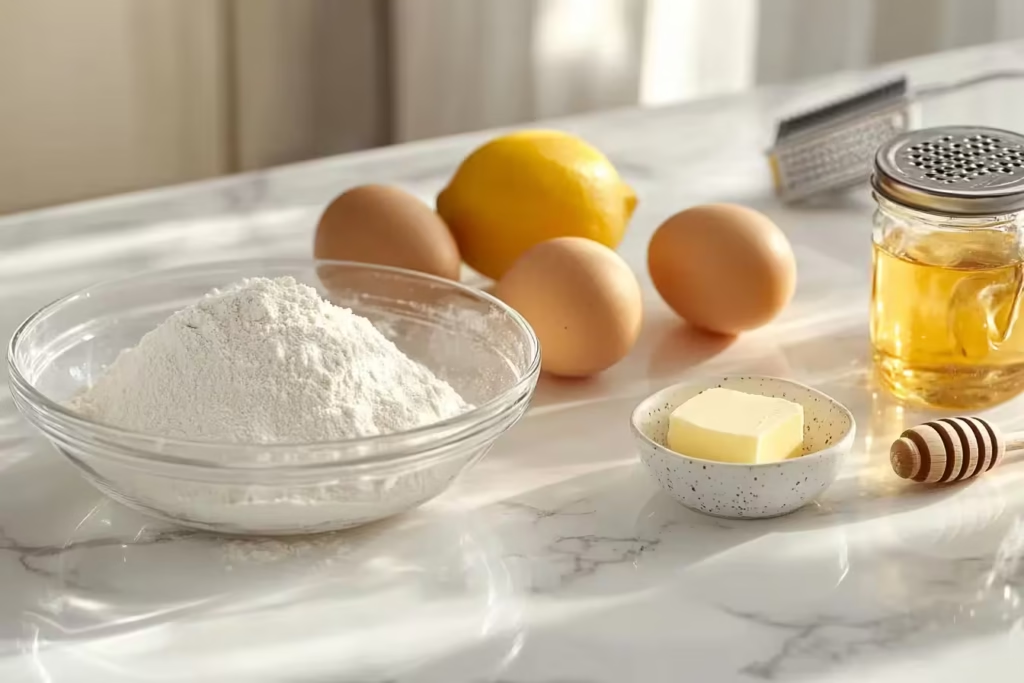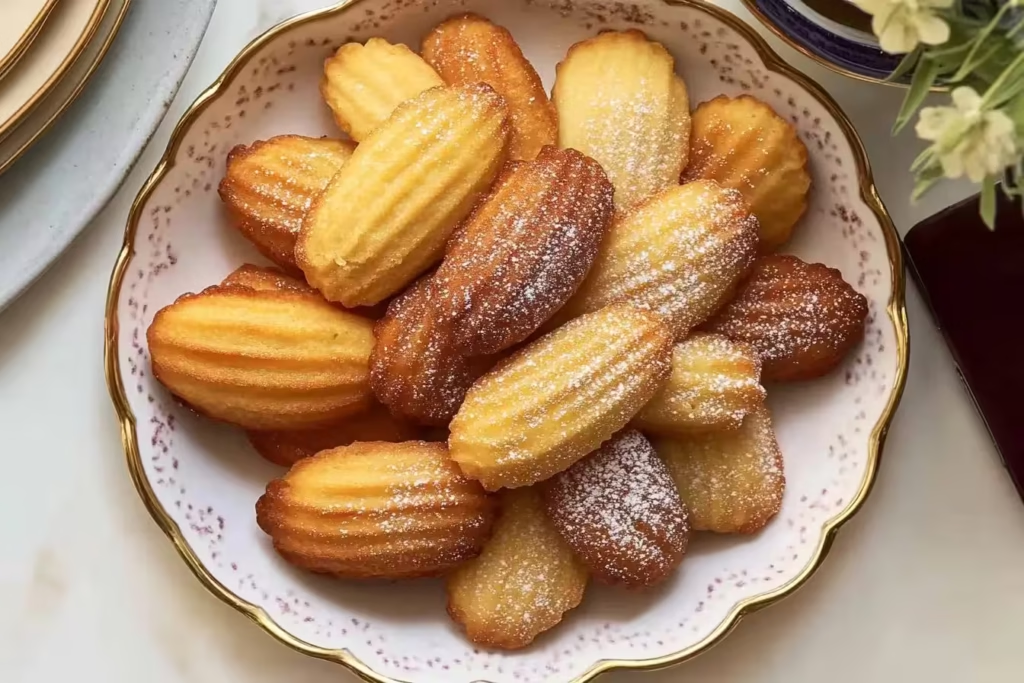Ever wondered why homemade madeleine cookies are so beloved? Their delicate taste and soft texture make them a French favorite. Discovering the best madeleine cookies means finding a balance between simplicity and elegance. This article will guide you through making these tasty treats.
When making homemade madeleine cookies, you’ll notice what makes them unique. With a recipe that makes 12 cookies, each with just 90 calories, you can enjoy them guilt-free. The mix of 1/2 cup all-purpose flour, 1/4 cup granulated sugar, and 1/4 cup unsalted butter gives them a special flavor.
Key Takeaways
- Homemade madeleine cookies are a classic French recipe that’s easy to make and delicious to eat
- A madeleine cookie recipe typically yields 12 cookies, each with approximately 90 calories
- The best madeleine cookies are made with simple ingredients like all-purpose flour, granulated sugar, and unsalted butter
- Homemade madeleine cookies can be customized with optional flavor enhancements like honey or lemon zest
- With a prep time of 15 minutes and a cook time of 10 minutes, you can have freshly baked madeleine cookies in no time
- These cookies are perfect for storing in an airtight container for up to 2 days or freezing for up to 3 months
- Whether you’re a beginner or an experienced baker, a homemade madeleine cookie recipe is a great way to explore the world of French patisserie
History of the Dish
Madeleines are a beloved part of French patisserie, with a history dating back to the 18th century in the Lorraine region of France. The most famous origin story credits a young baker named Madeleine Paulmier, who first made these delicate shell-shaped cakes in 1755 for the Duke was so impressed with the soft, buttery cakes that he introduced them to the French court at Versailles, where they quickly gained popularity.
Madeleines are often associated with Marcel Proust, the famous French writer, who described their taste in his novel In Search of Lost Time. In the book, he recalls how a bite of a madeleine dipped in tea evoked vivid childhood memories, solidifying the cookie’s status as a symbol of nostalgia and comfort.
Over time, madeleines have become a staple of French bakeries and home kitchens, enjoyed with coffee, tea, or as a light dessert. Today, they are baked around the world with variations incorporating citrus zest, chocolate, and even spices to suit different tastes.
Popular Variations
While the classic madeleine is a simple combination of butter, eggs, sugar, and flour, many variations have emerged to enhance its flavor:
- Lemon Madeleines – A hint of lemon zest or juice brightens the taste and adds a fresh, tangy flavor.
- Chocolate-Dipped Madeleines – Once baked, the cookies are partially dipped in melted dark or white chocolate for an indulgent touch.
- Honey Madeleines – Swapping some sugar for honey creates a deeper, caramelized sweetness.
- Spiced Madeleines – Adding a pinch of cinnamon, nutmeg, or cardamom infuses the cookies with warm flavors.
- Almond Madeleines – Incorporating almond flour or almond extract enhances the nutty aroma and creates a richer texture.
- Glazed Madeleines – Drizzling with a light citrus glaze (made with powdered sugar and lemon or orange juice) gives them a glossy finish.
These variations allow bakers to personalize their madeleines while keeping their light and fluffy texture intact. If you enjoy classic baking, you might also love our Giant Cookies !
Ingredients and Tools You’ll Need
To make perfect homemade madeleine cookies, you’ll need a few simple ingredients and essential baking tools.
🛒 Ingredients: (Yields 12 madeleines)
- ½ cup (60g) all-purpose flour – Provides structure to the cookies.
- ¼ cup (50g) granulated sugar – Adds sweetness and a light texture.
- ¼ cup (60g) unsalted butter, melted – Enhances richness and flavor.
- 1 large egg – Helps bind the ingredients together.
- ½ tsp vanilla extract – Adds depth and warmth to the flavor.
- ½ tsp baking powder – Helps create the soft, airy texture.
- 1 tbsp milk – Keeps the batter smooth and prevents dryness.
- A pinch of salt – Balances sweetness and enhances flavor.
- (Optional: 1 tsp lemon zest or honey for extra flavor.)

🛠️ Tools You’ll Need:
✅ Madeleine Pan – The signature shell-shaped molds are essential for authentic madeleines.
✅ Mixing Bowls – For combining the dry and wet ingredients separately.
✅ Whisk or Hand Mixer – Helps achieve a light, fluffy batter.
✅ Sifter – Ensures the flour and baking powder are evenly distributed.
✅ Pastry Brush – For greasing the pan with melted butter.
✅ Cooling Rack – Allows the cookies to cool properly and develop their texture.
👉 For best results, use high-quality butter and fresh eggs to achieve the perfect soft texture and delicate crumb!
Step-by-Step Instructions
Follow these easy steps to bake perfect homemade madeleines every time!
🥄 Step 1: Prepare the Ingredients
- Melt the unsalted butter and let it cool slightly.
- In a mixing bowl, sift together the flour, baking powder, and salt. Set aside.
🥚 Step 2: Whisk the Eggs and Sugar
- In a separate bowl, whisk the egg and sugar until the mixture becomes pale and fluffy (about 3-4 minutes).
- Stir in the vanilla extract and optional lemon zest for extra flavor.
🥛 Step 3: Combine the Ingredients
- Gradually fold the dry ingredients into the wet mixture using a spatula.
- Slowly pour in the melted butter and milk, mixing until just combined (do not overmix!).
❄️ Step 4: Chill the Batter (Essential for the signature “hump”)
- Cover the batter with plastic wrap and refrigerate for at least 4 hours (or overnight).
- Preheat your oven to 375°F (190°C) while the batter chills.
🥄 Step 5: Fill the Madeleine Pan
- Grease the madeleine pan with butter or non-stick spray.
- Spoon or pipe the chilled batter into each mold, filling them about ¾ full.
🔥 Step 6: Bake to Perfection
- Bake for 8-10 minutes, or until the edges are golden brown and a hump forms in the center.
- Remove from the oven and let them cool in the pan for 2 minutes before transferring to a cooling rack.
✨ Step 7: Serve and Enjoy
- Dust with powdered sugar or dip in melted chocolate for an extra touch!
- Serve warm with coffee, tea, or a light dessert wine.
💡 For an authentic French experience, pair your madeleines with a cup of Earl Grey tea or a classic café au lait!

Frequently Asked Questions About Madeleine Cookies
Many people wonder about homemade madeleine cookies. They ask about their origins, what makes them special, and how to enjoy them. We’ll answer some common questions about madeleines here. This includes their name, unique features, and how to serve them.
Why Is It Called a Madeleine Cookie?
The name “madeleine” comes from a young farmer named Madeleine in Commercy, France, who made these cakes in 1755. To make the best madeleine cookies, use a traditional madeleine cookie recipe. It includes all-purpose flour, granulated sugar, and melted unsalted butter.
What Is So Special About Madeleines?
Madeleines are special because of their unique flavor and texture. This is thanks to a mix of ingredients and techniques. Freezing the pan and refrigerating the batter before baking creates the signature hump. This makes them a delightful treat.
How Do the French Eat Madeleines?
In France, madeleines are enjoyed as a snack or dessert. They’re often paired with coffee or tea. You can serve them plain or with toppings like powdered sugar or a glaze made from lemon or orange juice.
What Is the Original French Madeleine?
The original French madeleine recipe has been passed down for generations. It includes all-purpose flour, granulated sugar, eggs, and melted unsalted butter. To make the best madeleine cookies, use a traditional madeleine cookie recipe. Follow these tips:
- Use high-quality ingredients
- Freeze the pan and refrigerate the batter before baking
- Bake at the right temperature (425°F or 220°C)
Conclusion
As we wrap up our look at simple madeleine cookies, it’s clear they’re a joy to make and eat. These French treats have a long history, dating back to the 18th century in France. They’ve won the hearts of many bakers and food lovers.
To make these buttery, shell-shaped cookies, you need to get the ingredients and techniques just right. Chilling the batter and getting the perfect hump takes practice. But the smell of freshly baked cookies is worth it, adding a French touch to your day.
So, why not try making these classic cookies yourself? With the right tools, patience, and love for baking, you can make delicious madeleine cookies. Enjoy the soft texture, the flavors, and the happiness of making a French classic in your kitchen.
